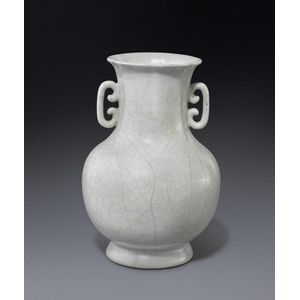Qianlong Guan-type Vase with Crackled Glaze
You must be a subscriber, and be logged in to view price and dealer details.
Subscribe Now to view actual auction price for this item
When you subscribe, you have the option of setting the currency in which to display prices to $Au, $US, $NZ or Stg.
- Crackles / Cracquelure - In ceramics, crackles may be introduced intentionally during the firing process, as was often the case with Oriental ceramics, and are known as artificial crackles. Natural crackles occur with age, and if the glaze is transparent, may be difficult to detect. Natural crackles may not cover the whole surface of the object and may be uneven in size.
- Crackling and Crackle as a Decorative Technique - Crackle, also known as crackling, is a decorative technique that has been used in China for centuries. It is believed to have originated during the Song Dynasty (960?1279 AD) and was primarily used in the production of ceramics, lacquerware, and furniture. The crackling effect was achieved by applying a glaze or lacquer that was formulated to crack during firing, creating a crackled pattern on the surface of the item.
During the Ming Dynasty (1368?1644 AD), crackle became a highly sought-after decorative technique, and it was used to create intricate and beautiful designs on ceramics and lacquer ware.
In Western decorative arts, crackle / crackling came into use during the Art Nouveau movement in the late 19th and early 20th century. The crackling effect was used to create a sense of movement and fluidity in the design of Art Nouveau pieces.
It was also used in the 1920s and 1930s during the Art Deco movement.
This item has been included into following indexes:
- Chinese ceramics, dynasty mark or period
- Chinese ceramics, item type - vases, other 2,484
Visually similar items

Chinese celadon vase. Dual handled, with moulded leaf dec. Possibly late Qing or Republic period. Height 35 cm

Chinese celadon vase. Dual handled, with moulded leaf decoration. Possibly late Qing or Republic period H35 cm

A Chinese Qingbai vase, Yuan dynasty, 14th century, with dragon and ring handle attached to each side of the neck, the body incised with a band of lotus flowers above a band of upright banana leaf motif, each side of the neck decorated with an upright bana

A William Moorcroft salt glaze 'Fish' jug circa 1930 of baluster form the body decorated with three fish swimming amongst foliage and water lilies. Height 17.3 cm. Signed to base
